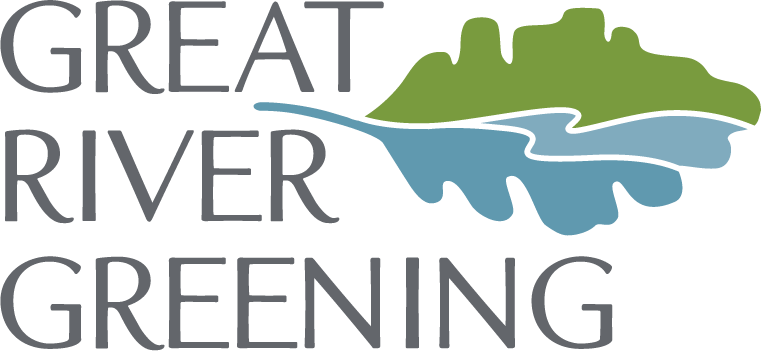Pollinator recovery in Central Minnesota
Great River Greening is partnering with key pollinator experts and landowners on plans for a 19-county pollinator recovery project along the Mississippi River, anchored by Hastings and St. Cloud.The plan, titled “Pollinator Central”, focuses on improving food access and shelter for winged pollinators, bumble bees in particular, that are crucial to our own food production and currently in steep decline. The rusty patched bumble bee, for example, has been added to the endangered species list. Just 20 years ago, this native pollinator was a common sight across eastern United States, Upper Midwest, and Canada. In that time, it has declined by 87 percent.Pollinator Central restores and enhances 18 traditional and non-traditional sites, to achieve a 430-acre “hopscotch” corridor; pollinator charging stations that wind through a variety of settings, from populous urban neighborhoods to rural stretches in Central Minnesota.The two-fold plan also incorporates community stewardship by engaging citizen monitors to assist in monitoring and evaluating the project’s impact.
A vision in line with the state’s top priorities
Great River Greening and its partners, The Xerces Society for Invertebrate Conservation, the University of Minnesota Bee Lab, and several landowners, are hoping the Minnesota Environment & Natural Resources Trust Fund will provide funding to support the plan. The Pollinator Central proposal was submitted this spring to the Legislative-Citizen Commission on Minnesota Resources (LCCMR), which will meet over the summer to make funding recommendations for the ENRTF.Much of the plan was developed in utilizing recommendations from a pollinator task force convened by former Governor Mark Dayton and recently endorsed by Governor Tim Walz. Recommendations from the task force’s report call for replacing or enhancing turf with flowering habitat in urban, suburban, and rural nonagricultural lands. The non-traditional habitat sites in Pollinator Central include turf along state highways and other small areas. To boost the impact of turf conversions, the plan includes traditional habitat cores, such as prairie, wetland, shoreline, and woodland.The 18 sites in the first phase of this plan comprise regional parks and nature centers, city basins and urban parks, spanning several counties, including Liberty Glen Park (Sherburne), Woodbury basins (Washington), Lebanon Hills Regional Park (Dakota), and Crosby Farm Regional Park (Ramsey).
We’re very excited about the vision this proposal holds. Each science partner brings a unique and crucial expertise. Bringing together so many different land owners in Central Minnesota magnifies the impact. And there really is no better way to teach people about pollinator recovery, and get them excited about it, than through hands-on restoration and citizen science.
-GRG Ecologist Wiley Buck
Connecting to the environment through science
Central Minnesota is one of the few regions where the rusty patched bumble bee can still be found, with concentrations at either end of the Pollinator Central corridor. Buck said restoring sites in this part of the state, and monitoring each one for success in food supply, nesting, and overwintering habitat, will add crucial data to the research needed for best restoration practices.Xerces, in tandem with the GRG and Bee Lab, will oversee 450 volunteers, some as citizen scientists who will monitor pre- and post- restorations, to learn what benefits Species of Greatest Conservation Need. They will determine the value of the sites, the enhancements, and the vegetation by looking at micro-habitat success, and counting three categories of winged pollinators, in timed intervals.Great River Greening will also train skilled volunteer photographers in methods that will provide the best visual monitoring, host community restoration events and Bumble Bee Surveys, where volunteers will work with experts to catch and release pollinators for identification.
Ensuring our food supply concerns us all. Citizen science is a fantastic way to engage people – it provides a rich learning environment and the opportunity for everyone to make an impact. It can be collected in so many ways –during a single event, or in an ongoing way, through photos, or taking notes during a hike. The data is invaluable to researchers, land managers, ecologists, and all of us who want do the best we can for pollinator recovery and restoration.
-Wiley Buck
The LCCMR will meet this summer to begin the process of evaluating project proposals. We’re hopeful the commissioners will see the value in supporting this important effort to restore critical habitat for pollinators in communities across the state. Learn how you can benefit our winged pollinators in your own gardens. https://www.fws.gov/midwest/Endangered/insects/rpbb/pdf/MidwestPlantGuideRPBB.pdf
